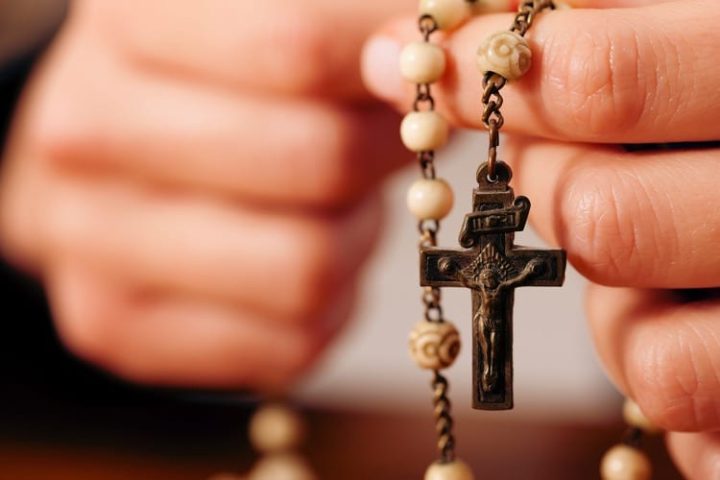
If you’re Catholic and you pray the Rosary, watch out. You might be a hater, and the hate-watchers are keeping an eye on you just in case.
That news appeared on August 14, when the leftist Atlantic published a hate piece about old-fashioned Catholics who pray the Rosary from a writer who writes about “hate.”
Daniel Panneton, a “public historian,” claims that “gun culture” is co-opting the centuries-old prayer to spread hate. But as is typical with screeds of this sort, he offers no real evidence that the Rosary is anything but what it has always been: a Catholic devotion.
The piece betrays the hate and ignorance not only of the “hate” writer, but also of the magazine, which knew just enough to publish the piece on the Vigil of the Feast of the Assumption of the Blessed Virgin, which celebrates the bodily assumption of the Mother of Christ into Heaven.
“Demonize” Their Opponents
The publication date is significant because the traditional Rosary is a Marian devotion that entails 15 decades of prayers comprising 150 Hail Marys, 15 Our Fathers, and others. Thus, Panneton’s anti-Catholic thumb in the eye was perfectly timed.
“Just as the AR-15 rifle has become a sacred object for Christian nationalists in general, the rosary has acquired a militaristic meaning for radical-traditional (or “rad trad”) Catholics,” the Canadian writer began:
On this extremist fringe, rosary beads have been woven into a conspiratorial politics and absolutist gun culture. These armed radical traditionalists have taken up a spiritual notion that the rosary can be a weapon in the fight against evil and turned it into something dangerously literal.
Their social-media pages are saturated with images of rosaries draped over firearms, warriors in prayer, Deus Vult (“God wills it”) crusader memes, and exhortations for men to rise up and become Church Militants. Influencers on platforms such as Instagram share posts referencing “everyday carry” and “gat check” (gat is slang for “firearm”) that include soldiers’ “battle beads,” handguns, and assault rifles. One artist posts illustrations of his favorite Catholic saints, clergy, and influencers toting AR-15-style rifles labeled sanctum rosarium alongside violently homophobic screeds that are celebrated by social-media accounts with thousands of followers.
Sans evidence, Panneton claims this imagery — to the degree he accurately portrays it — could lead to terrorism:
The far right’s constellations of violent, racist, and homophobic online milieus are well documented for providing a pathway to radicalization and real-world terrorist attacks.
The far left’s “constellations” of anti-white, anti-Christian, and anti-American “online milieus” provided a “pathway” to two years of riots after myriad racial hoaxes, but that small fact aside, Panneton delivers a mish-mash of uninformed opinion larded with claims for which he offers zero evidence:
The rosary — in these hands — is anything but holy….
The militarism also glorifies a warrior mentality and notions of manliness and male strength. This conflation of the masculine and the military is rooted in wider anxieties about Catholic manhood.… But among radical-traditional Catholic men, such concerns take an extremist turn, rooted in fantasies of violently defending one’s family and church from marauders.
Panneton didn’t name a single one of these men, or explain what their “fantasies” entail. Nor does he adduce evidence for this claim:
Christian nationalism’s nativism and its predilection for “Great Replacement” theory alienate some radical-traditional Catholics who are not white or who were not born in the United States, and deep veins of anti-Catholicism persist among far-right Protestants.
Of course, Panneton also frets about “hostility to abortion rights advocates,” a staple of hysterical leftist journalism. Funny thing is, the only violence connected to abortion of late has come from deranged feminists. They attacked pro-lifers and published the addresses of the U.S. Supreme Court justices who voted to overturn Roe. v. Wade.
Panneton sees the existential struggle with the Father of Lies as a problem, too. “Catholics are taught to love and forgive their enemies, that to do otherwise is a sin,” he writes:
But the extremist understanding of spiritual warfare overrides that command. To do battle with Satan — whose influence in the world is, according to Catholic demonology, real and menacing — is to deploy violence for deliverance and redemption. The “battle beads” culture of spiritual warfare permits radical-traditional Catholics literally to demonize their political opponents and regard the use of armed force against them as sanctified. The sacramental rosary isn’t just a spiritual weapon but one that comes with physical ammunition.
In other words, Catholics in particular and Christians in general must surrender their belief that Satan is real, that he acts in the world, that he tempts human beings to commit sin, and that spiritual warfare using practical tactics — prayer, education, and evangelism — is the only way to defeat him.
Panneton did not cite any Catholics convicted of crimes after immersing themselves in this online world of “hate.”
Hate Watcher
Panneton’s qualifications to write about Catholics, spiritual warfare, or the commands of the Christian religion are, of course, a mystery. He is not a theologian.
His day job, though, might explain his hostility to traditional Catholics. He manages the “Online Hate Research & Education Project” for the Sarah and Chaim Neuberger Holocaust Education Centre in Toronto, Canada.
Leftists of Panneton’s ilk widely believe the anti-Catholic canard that Pope Pius XII is partly responsible for the Holocaust.



